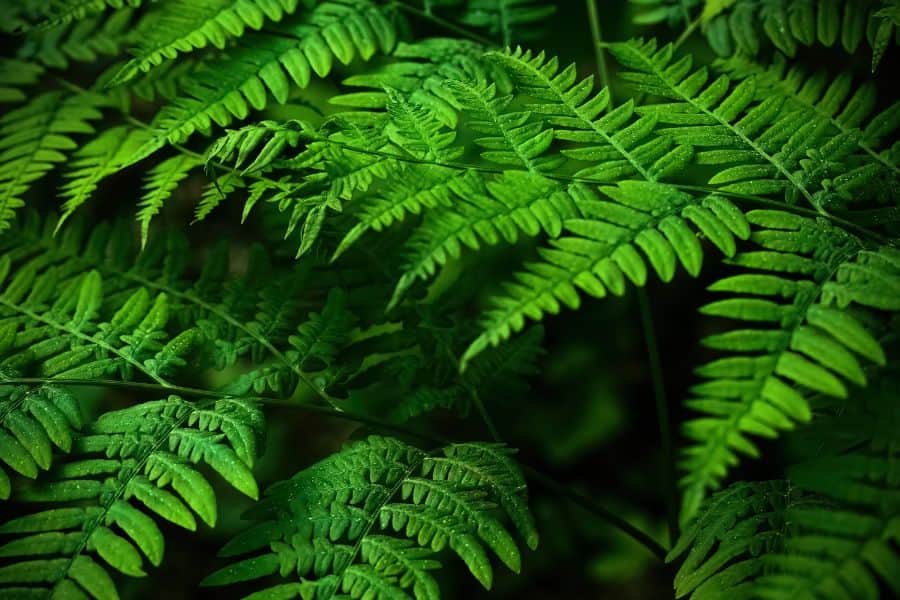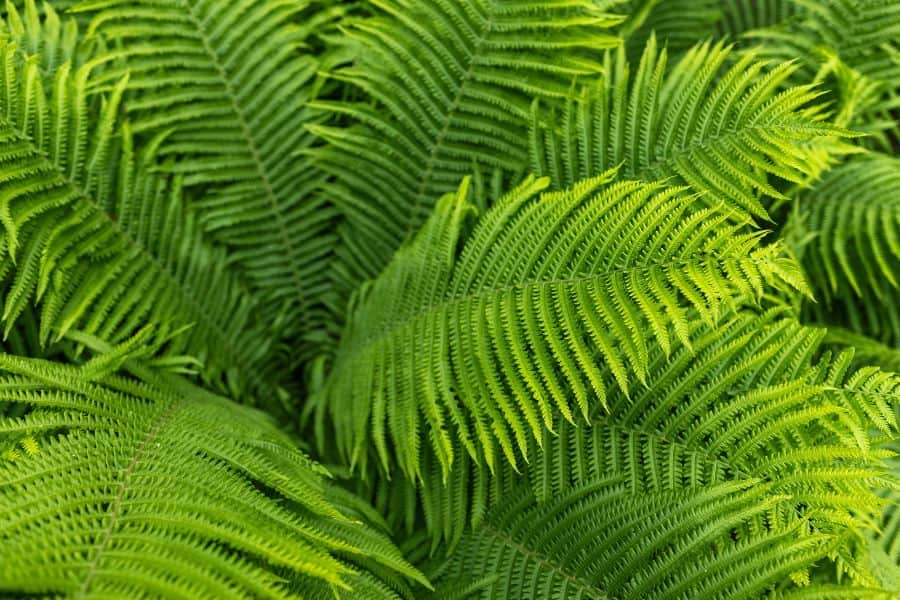Ferns are a popular choice for many homeowners, both as houseplants and in the landscape as perennials. These leafy, green plants are not only beautiful but also offer a range of benefits, including air purification and stress reduction. Ferns are known for their lush foliage and air-purifying properties. Studies have shown that Ferns can help reduce stress levels and boost productivity. Having these houseplants in your home can create a calming atmosphere and help you feel more relaxed and focused. Having them in your outside landscape can do the same.

A Care Guide For Ferns
Most ferns prefer bright, indirect light. Avoid placing them in direct sunlight, as this can scorch their delicate leaves. If your home doesn’t receive a lot of natural light, consider using artificial grow lights. Ferns prefer moist but well-draining soil. Water your ferns regularly, making sure the soil is evenly moist but not waterlogged. Avoid letting the soil dry out completely between waterings, as this can cause the fern to wilt.
Ferns thrive in high-humidity environments. If your home is dry, consider using a humidifier or placing a tray of water near your ferns to increase humidity levels. Feed your ferns with a balanced, water-soluble fertilizer every four to six weeks during the growing season. Lastly, regular pruning can help keep your ferns looking neat and healthy. Trim any brown or yellowing leaves, as well as any fronds that are growing too long or too close to other plants.
Foliage
The foliage of ferns is one of their most striking features, with their delicate fronds and intricate patterns. The fronds of ferns are typically long and narrow, with finely divided leaves that can be symmetrical or asymmetrical. Ferns also come in a wide range of shades of green, from light and bright to dark and rich. Some ferns have variegated foliage, with patterns of white or yellow on their leaves. Ferns can add texture and interest to any indoor space.

Perennial Ferns
Perennial ferns come in both herbaceous and evergreen varieties. At Martin Garden Center, we carry several evergreen ferns including:
- Arborvitae Fern
- Autumn Fern
- East Indian Holly Fern
- Fortunes Holly Fern
- Holly Fern
We attempt to keep all of these evergreen ferns in stock year-round though we may fall short from time to time. For the above, we often have 4″ and 1, 2- and 3-gallon except for Arborvitae ferns which are only available in 1-gallon or more.
Martin Garden Center also provides a plethora of perennial herbaceous ferns. These include but are not limited to the following:
- Ostrich Ferns (Matteuccia struthiopteris)
- Royal Fern (Osmunda regalis)
- Cinnamon Ferns (Osmunda cinnamomea)
- Japanese Painted Fern (Athyrium niponicum)
- Christmas Fern (Polystichum Acrostichoides)
- Southern Shield Fern
- Sensitive Fern (Onoclea Sensibilis)
Houseplant Ferns
While perennial ferns can often be used as houseplants, the annual Ferns listed herein are tropical and will not survive winters in the Upstate. Consequently annual Ferns must not be exposed to a frost and therefore are considered houseplants. Some of the most popular houseplant Ferns at Martin Garden Center include:
- Macho Fern and Kimberly Queen Fern, large ferns that come in 10″ pots. These are used in decorasitive Fern (Onoclea Sensibilis)tive entry pots and as annual accents in a lush landscape.
- Boston Fern used in hanging baskets. At Martin Garden Center we carry huge 12″ HBs in the early spring that have been overwintered and grown in our greenhouse. These coveted giants don’t last long so be prepared to purchase them early. We also stock 10″ HBs of Boston Ferns all season long if possible.
- Asparagus Fern (aka, Sprengeri) are also available in 10″HBs and sometimes 12″HBs. We also try to have 4″ Sprengeri available throughout the spring because of its popular use in mixed containers. Foxtail Fern (aka, Meyeri) may also be available in HBs, 4″ and other sizes if available through our vendors.
- Button Fern, Lemon Button Fern, Mother Fern, Blue Star Fern, Maidenhair Fern (a tender perennial), Bird’s Nest Fern, Rabbit’s Foot Fern, Crocodile Fern, Pteris Fern, Staghorn Fern, and other varieties are typically found at Martin Garden Center in a 4″ and sometimes 6″ pot. These varieties of houseplant ferns are stocked in our Greenhouse. Not all varieties are always available but we always have a variety of 4″ and 6″ houseplant Fern.

Frequently Asked Questions
Are Ferns Toxic to Cats and Dogs?
Many ferns are considered non-toxic to pets; however, not all fern species are safe. Some ferns may cause mild gastrointestinal upset if ingested, while others can have more serious symptoms. If you are concerned about ferns in your home, identify the species of fern you have or are looking to purchase. Some toxic ferns include Autumn, Bracken, and Leatherleaf Ferns.
Are Ferns Perennials?
SOME ferns are perennials, meaning they live for more than two years. Ferns are non-flowering, vascular plants that reproduce via spores instead of seeds. They have a distinct life cycle that involves the alternation of generations between a sporophyte stage (the visible fern plant) and a gametophyte stage (a smaller, often inconspicuous stage). While individual fronds may die back or be replaced, the main fern plant remains, and new fronds typically emerge from the center of the plant.
Are Ferns Edible?
Some ferns are edible, while others are toxic and should be avoided. Fiddlehead ferns are young, tightly coiled fronds of certain fern species and are one of the most well-known ferns for culinary use. However, Bracken ferns contain carcinogenic compounds ad should not be consumed under any circumstances.
Do Deer Eat Ferns?
Deer are known to browse on various plants, and ferns are no exception. While not typically one of their preferred food sources, deer may still nibble on ferns, particularly young shoots and tender fronds.
